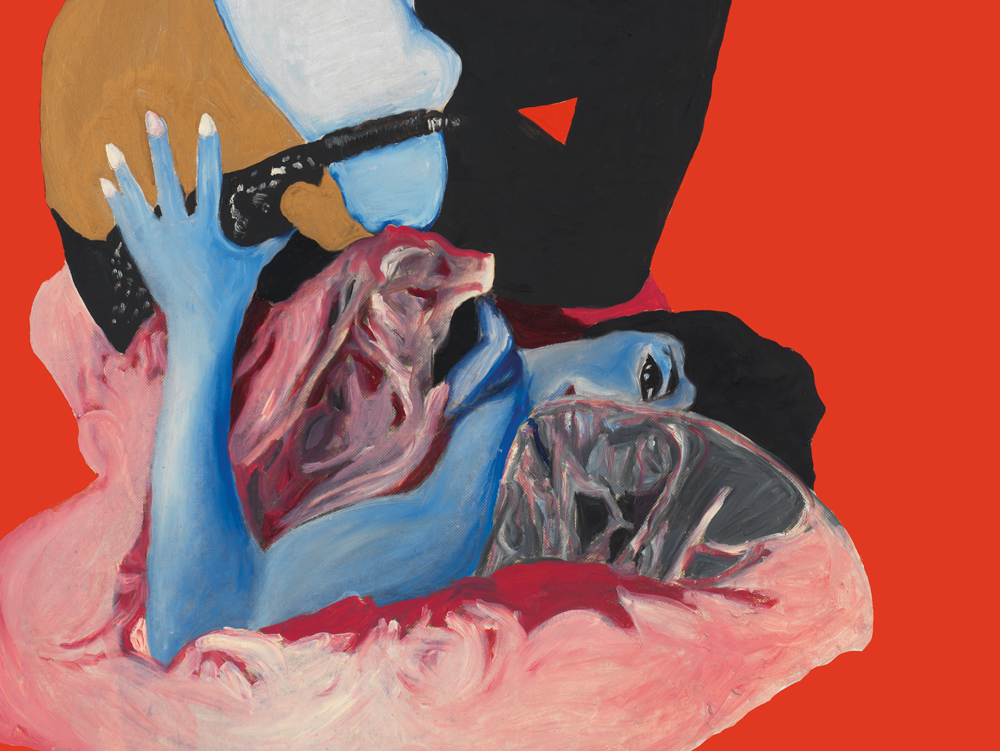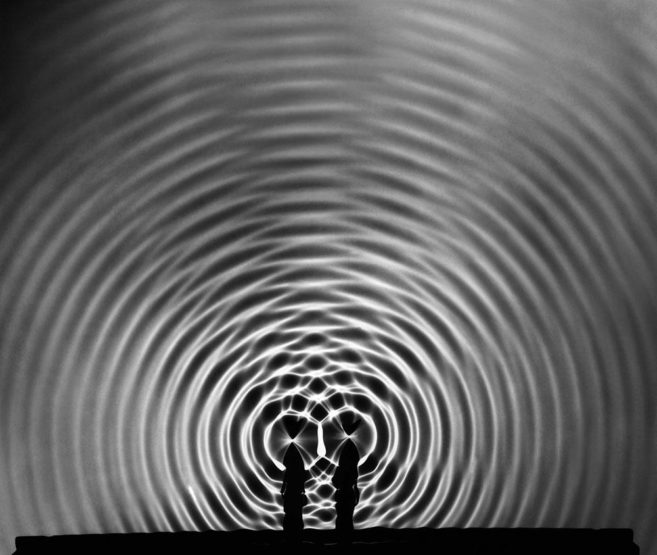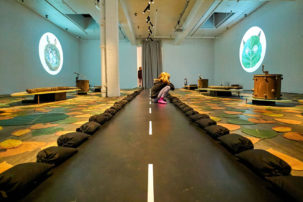Art and writing, for New York artist Rosalyn Drexler—who currently has a retrospective at Buffalo’s Albright-Knox Art Gallery—have always been a rescue mission, an attempt to save someone, usually herself, from a bad situation. “When I first began writing,” she says, “I’d listen to my parents’ arguments. And they would kick me out if I asked them to please stop yelling. And so I’d listen very carefully and I’d write everything that was said and present it in the morning. And got some reaction from it…So I got to know the value of writing, especially honest writing.”
Drexler would later describe her turn to art, when she was in her early 30s, in similar terms. This time, it rescued her from the boredom of being a housewife and mother. She started cobbling together junk from her drawers into assemblage sculptures. Over the next six decades, Drexler became very active, contributing great work not only to the art world, through her excellent Pop Art paintings, but also to the siloed worlds of theatre and literature. And she did so while maintaining a cult, outsider status, mainly because, instead of running with the crowd at Warhol’s factory or engaging in other social rituals that come with being a part of a scene, she was at home, making that great work, and raising her family. Whatever the reason, Drexler, the proto-feminist-vanguard painter, sculptor, playwright, novelist and former lady wrester, is criminally unknown.
To this end, the curator of Drexler’s retrospective, Amy Siegel, has performed her own kind of rescue mission. It’s astonishing. The bulk of work is indeed Drexler’s 1960s Pop Art paintings, which have again resurfaced in an art world finally reconsidering its previously overlooked females. But this show, titled “Who Does She Think She Is?,” marks the first time the many fragments of Drexler’s storied, multifarious career have been exhibited as a whole. The truth is, there were never silos for Drexler. Her paintings get at the same themes of gender, identity and violence that her plays and novels do. The exhibition is also the first time her early assemblage sculptures have been exhibited since 1960, when she switched to painting. These are contextualized alongside collages and drawings, scripts, screenplays, novels and various photographic documentation of her participation in happenings, and other ephemera from her outrageously eccentric and prolific life.
A glance at Drexler’s output: 10 works of fiction, all released by different publishers, plus five more under the pseudonym Julia Sorel (including Rocky, a novelization of Sylvester Stallone’s screenplay); dozens of pieces of criticism; three Obie Awards for her plays; and an Emmy, as screenwriter for The Lily Tomlin Special. At 90 years old, Drexler is still painting.
Like all of her work, Drexler’s paintings are about characters caught up in a moment of action or a calamitous circumstance. Happy white men pose with their giant computers; a crowd carries a woman on a gurney over a vertical film-strip plane; a giant Marilyn Monroe rushes to the right of the frame to escape a threatening male pursuer, and it feels as if we, the viewer, are the paparazzi blocking her escape; a man hits a woman, her face turned from the immediate impact. Drexler sources her figures from B-movie posters or other mass media, then cuts and pastes, or resizes, and paints over the reproduction on the canvas, encasing the action in a flat plane of bright, disembodying colour. Unlike her contemporaries, whose work sought to mimic mechanical production, Drexler uses paint as a force, to fix her characters in time, re-framing them on the canvas with colour’s sharp edge. By covering the source image with a crude layer of paint, she reveals new emotional resonances. Male power and violence, acting on the world through their machines, and on the bodies of the women they desire, are the bullseye of Drexler’s target.
The Syndicate (1964) hangs at the entrance of the exhibition: a 5-by-6-foot, mirrored, double-paneled depiction of about a dozen men in Don Draper suits seated casually around a long table, negotiating a deal. Like all of her early works, the colour field is canary yellow, and Drexler’s application of paint on the figures in the foreground reduces their features to lights and darks. This presumably powerful group of men is rendered by Drexler into an anonymous mob, a unified collective, caught up in the performance of their roles. Nearby, in a smaller work, a banal, aging white man stands proudly in his bathrobe, holding up a razor, with a towel folded on his other arm, his face coated in shaving cream. Its title: God Shaves, 1961. Drexler softens through domesticity, taking aim at the Great Almighty by depicting Him in a private moment of self-grooming.
Much of the work is far less delicate. Drexler’s self-stated existential theme is, after all, “the human dilemma—hit or be hit.” In Kiss Me Stupid, 1964, a man and a woman embrace in a kiss while he grabs her wrist forcefully. In I Won’t Hurt You (1964), a man reaches around to grip a woman’s throat. Drexler portrays male desire as a menace. In The Dream (1963), that menace is quite literally a beast, an image of King Kong becoming a stand-in for the looming threat of male violence over a terrified object of desire. Rape and Self-Defense (both 1963) are nearly identical compositions of gendered interaction, the first depicting a man hovering over a reclining woman in a moment that could be read as a seduction or an attack, the second depicting a bare-breasted woman pinning her attacker on the ground with her knee as they struggle over a gun and she claws at his face. The violence is not always male. In Take Down (1963) and Lost Match, 1962, Drexler paints ladies wrestling, with the referee holding up the arm of the apparent victor, who stands over the body of her opponent. The winner, however, is hunched over despondently, suggesting that it is she who has lost. For Drexler, there are no winners or losers. “To be alive is to attack,” she says, “although to be alive is also to fall down.”
Drexler’s preoccupation with roles led her to insert her own image and autobiography into her work. Every major turn in her career coincided with a self-portrait. The earliest, a 1960 assemblage sculpture, Portrait of Rosalyn Drexler, is a crudely rendered, red-lipped visage, painted with acrylic on a clustered mass of plaster, and attached to a wooden handle. A mask: there couldn’t be a more perfect object for Drexler. After her turn to painting she made two portraits, this time playing with gendered Hollywood clichés of so-called “dangerous women,” and using self-objectification in a way that Cindy Sherman would do a decade later.
In Chain Smoker, the artist depicts herself as a moll, a role, which, I can imagine, would be its own escape fantasy for a girl of Drexler’s social class, growing up as she did in the Depression-era Bronx. In Self-Portrait, she depicts herself as a raunchy pin-up, an image sourced from a 1957 issue of Ultra, in which Drexler also appeared in a photo spread called “Album of a Mat Queen,” riffing on the character (Rosa Carlo, The Mexican Spitfire) that she played during her time spent travelling the country wrestling. (This image of Rosa would later be appropriated by Andy Warhol in silkscreen paintings named after the character.)
In 1965, Drexler published her first novel, I am the Beautiful Stranger, a salacious autobiographical account of her precocious adolescence, and another in 1972, To Smithereens, about the wrestling period. Then there is 1989’s painting, Portrait of the Artist, made after a return to the medium. Here, Drexler’s multiple guises come together in one frame. Dressed in a man’s suit and wearing a mask (nodding to her involvement in theatre), she covers her mouth with one hand, and wears a wrestling glove on the other, with which she lightly holds a paintbrush. An airplane sits on her head, perhaps symbolizing the flight of the mind, the imagination—the ultimate machine of her own rescue.









